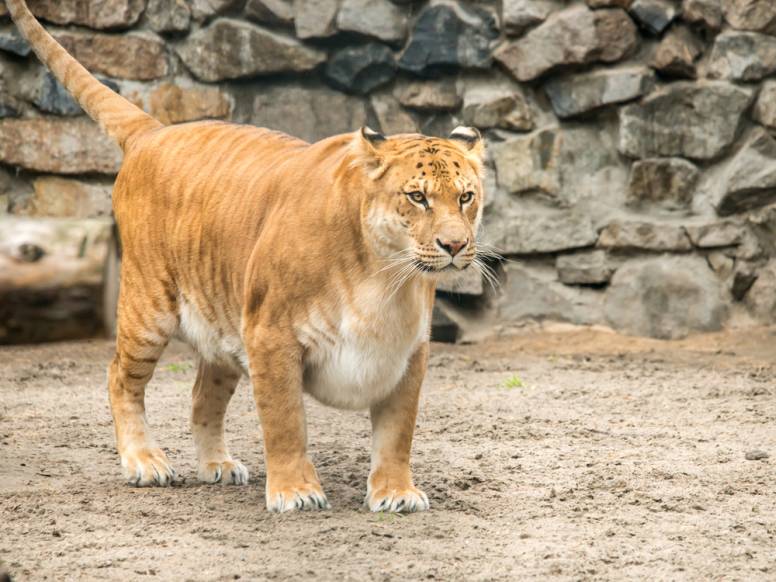LIGER Panthera
miércoles, 26 de junio de 2019
Liger Facts
The liger is a hybrid offspring of a male lion and a female tiger. The liger has parents in the same genus but of different species. It is distinct from the similar hybrid tigon, and is the largest of all known extant felines.
Key Facts & Information
PHYSICAL CHARACTERISTICS
The liger is the largest of the world’s felines, known to grow up to 12 feet tall when standing on their hind legs. The liger is an enormous animal with a large muscular body and broad head.
Ligers tend to have sandy or dark yellow fur which is covered in distinctive faint stripes inherited from their mother. Although other variations in fur color have been known (including white when their mother is a White Tiger), the liger generally has a more lion-like appearance including the mane of the males.
Along with their stripes, which tend to be most noticeable around their hindquarters, the liger may also inherit the spots found on the backs of tiger’s ears along with the tufted fur around their chins.
HABITAT
Ligers don’t occur in the wild because tigers are mainly found in Asia while lions are mainly in Africa. These two species do not cross paths in the wild. That is why ligers live in zoos, sanctuaries, and with their private owners.
BEHAVIOR
Despite their gigantic size and the fact that their parents are two of the planet’s most ferocious predators, the liger is known to have a relatively gentle and docile nature particularly when interacting with handlers.
They have, however, been reported to be slightly confused as to whether or not they are lions or tigers as their most bewildering characteristic is the fact that they seem to love water.
In the wild, it is common for tigers to enter water either to catch prey or to cool down in the heat and so they are naturally good swimmers, which is something that the liger seems to have inherited.
Another odd thing is the fact that the liger appears to make both lion and tiger noises, but its roar is more like that of a lion.
DIET
Like the rest of the world’s felines, the liger is a carnivorous animal that hunts and kills other animals in order to gain its nutrition.
In captivity, they tend to eat an average of 20 lbs. of meat a day but it is thought that a liger would easily devour 100 lbs worth of food in one sitting.
The liger has an enormous and incredibly strong jaw with sharp, pointed teeth which are ideal for tearing through flesh. Ligers also have very muscular bodies and sharp claws which also help them catch and eat their prey.
PREDATOR AND THREATS
If they were found in the wild, the liger would be the most dominant predator and their environment would therefore have no natural predator to worry about, with the obvious exception of humans. The same as lions and tigers, ligers would be subjected to hunting for trophies.
In captivity, many liger cubs are born with fatal birth defects due to the fact that it is the result of cross-breeding of two different species.
Another problem to consider is the unnatural nature in which ligers are both bred and kept all around the world. It is highly unlikely that ligers can occur in the wild today. They are merely being bred and kept by zoos in order to make money.
RELATIONSHIP WITH HUMANS
The liger has been bred by people since the early 19th century when a litter of liger cubs was born in Asia in 1824. However, it was more than 100 years until the next recorded litter, which was in a zoo in South Africa just before World War II.
Although ligers are known to be even tempered, there remains much controversy over the crossbreeding of two different species, particularly when it happens without human intervention.
Today, there are a number of ligers found in zoos and animal institutes around the world, who are bred (generally by accident) and kept as a money-making attraction.
CONSERVATION
There is no real scientific name assigned to the liger due to the fact that it is made from cross-breeding two separate species artificially. Since it is not found in the wild, the liger has no conservation status.
The liger is found in only a handful of enclosures on the planet but they remain frowned upon by many as they do not exist in the wild and therefore have no value as such to conservation.
Tigons (hybrid cross between a male tiger and a female lion) are more rarely found than ligers today. However, in the late 19th and early 20th centuries, there were more of them than there were ligers. The breeding of ligers is now banned in a number of countries around the world.
Source: https://kidskonnect.com/animals/liger/
sábado, 1 de junio de 2019
The mixture makes the animal Die Mischung macht das Tier
An upload showing a giant cat that is said to be the result of a cross between a lion and a tiger or a liger (lion tiger) that is widely talked about on social media. This happened after Kody Antle uploaded her intimacy with Odin, her pet liger who was 6 years old.
If examined more deeply, this crossing is considered to violate the nature of nature. The natural habitat of tigers is in Asia, while the natural habitat of lions is in Africa. So certainly there is nothing natural about the existence of a liger.
"Marriage between lions and tigers will not occur in the wild," said Susan Bass, director of public relations for Big Cat Rescue, the organization for saving the world's big cats as reported by The Dodo.
"Unfortunately, that happens when big cats caught from different species are kept together because irresponsible breeders and exhibitors know that people will pay more to see this unusual rare exotic cat," he explained.
Bass assessed, because interbreeding is contrary to nature. Besides because many will be brought on display at the show because of their uncommon physique, there are many other things that lurk their safety too.
Tiger mothers who are forced to contain liger often experience life-threatening difficulties due to giving birth whose size does not match their bodies. So it's not surprising that there are only around 30 animals like him in the world, although the estimates vary.
Not only that, liger often suffer from birth defects and other health problems. The Liger, if they survived their early childhood, could grow almost twice as big as one of their parents.
Because they become very large, their organs cannot take it and their hearts can give because of their small body size.
"Breeding cats is a matter of money," Bass said. "The well-being and health of children do not fit in. The recent birth of a liger child at a zoo in Russia is a perfect example of that." Bass explained again.
Ligers are not the only example of big cats that are forced to breed unnaturally to make money for their owners. White tiger is also not a natural species, but the result of blood mating.
Bass added that one way to defend tigers and lions that can be forced to breed nature is by never paying to see.
domingo, 19 de mayo de 2019
Pingtung’s liger reaches rare age of nine
A liger that was adopted by an animal rescue center in Pingtung County shortly after it was born is now nine years old, which is rare for the mixed species, the National Pingtung University of Science and Technology’s Rescue Center for Animals said.
A liger refers to the offspring of a male lion and a female tiger.
A-biao (阿彪) came to the center in 2010 after the Council of Agriculture seized it from a local farmer.
The farmer had put a male African lion and a female Bengal tiger into a pen together and bred them “for amusement” in contravention of the Wildlife Conservation Act (野生動物保育法), the council said.
Three cubs were produced from the litter, one of which died immediately after birth and another which died a week later, but A-biao survived, despite having a deformed spine due to missing DNA, the center said.
Under the care of center staff, A-biao has survived to the age of nine, but he has had a difficult life, the center said, adding that it hopes A-biao serves as a reminder about the need to respect wildlife.
“The long-term expenses for raising [A-biao], including the cost of medical care and other resources, has been no small sum. Conservation is also getting costlier. Now more than ever we need the public’s help,” the center said.
Any donations would be put toward improving facilities for the animals, it added.
A-biao, like most ligers, is larger than either of his parents. He was born with a spine shaped like an “s,” a tail that was missing bones and an inoperative left hind leg, the center said.
University professor Pei Jai-chyi (裴家騏) said that many of the animals at the center are exotic animals that were smuggled into the country and later abandoned, such as orangutans, sun bears and African spurred tortoises.
Taiwan was once notorious for animal smuggling, but has since become known for its conservation work, he said.
However, funding for conservation has been shrinking over the past decade, he added.
The center receives 95 percent of its funding from the Forestry Bureau, which has slashed its conservation budget more than 30 percent over the past 10 years, he said, adding that the center relies on two vets, two assistant vets and 17 caretakers to look after 1,500 animals.
Source: http://www.taipeitimes.com
#liger
#adopted #animal #rescue #center #Pingtung #County #mixed
#species #National #University #Science #Technology
jueves, 25 de abril de 2019
18 Astonishing Liger Facts - Fact Animal
Ligers only exist in captivity today, because the habitats of the parental species do not overlap out in the wild. They typically grow much larger than either parent species.
Another hybrid from the mating of the same animals – only reversed, a male Tiger and a female Lion – is known as the Tigon, and are often much smaller.
Liger Facts Overview
| Habitat: | Do not occur naturally in the wild. | ||
| Location: | Zoos & private ownership. | ||
| Lifespan: | 15 – 25 Years | ||
| Size: | 9.8 – 12 ft (3 to 3.6 m) | ||
| Weight: | 705 – 1,200 pounds (320 – 550 kg) | ||
| Color: | Tawny, with feint tiger stripes. | ||
| Diet: | Wild deer, boar | ||
| Predators: | No natural predators, but potentially other big cats. | ||
| Top Speed: | 80 kph (50 mph) | ||
| No. of Species: |
1 | ||
| Conservation Status: |
Not listed |
Ligers tend to be more like a lion, than a tiger.
They are large, muscly and male ligers will have a mane, like a male lion, but often shorter than their father’s. They have dark tawny fur, with broad heads. They often have feint tiger stripes, inherited from their mother. Ligers are fond of swimming, just like Tigers (lions don’t like water), and are also quite sociable, just like lions.
The Liger is not a new hybrid as they date back to the early 19th century in India. The name was coined to describe the creature in the 1930s. The Liger has appeared in art as far back as 1798 when a color plate depicted one, and in 1825 a Liger and its parents appeared in an engraving. A pair of Liger cubs born in 1837 were even put on display for King William IV and Queen Victoria who succeeded him.
While thought to be extremely rare, historically lions and tigers may have interbred to produce ligers in the wild. The Asiatic lion once inhabited a much larger area of Asia, that may have meant it shared some territory with tigers. However, today, they are very much only cross bred in captivity, either accidentally or more often, purposefully as a rare attraction.
Interesting Liger Facts
1. The Liger is the largest known cat in the world.
Male Ligers can reach a length of 10 to 12-feet which makes them slightly larger than even large male lions or tigers in length. They weigh considerably more than a Tiger or Lion. A non-obese male Liger named Hercules was recognized as being the largest living cat on Earth in 2013, when he weighed a total of 922 pounds. He measured 3.33 m (131 in) and stood at 1.25 m (49 in) at the shoulder.2. It’s estimated that there are fewer than 100 Ligers in existence.
The exact number is unknown, but this approximation is from Usman Masood who runs the website ligerzoos.com, and tracks reports of genuine ligers from around the world.The USA is thought to hold the largest number of ligers, around 30 are in private hands. This is followed by China with approx. 20. The photo below is a Liger in the Siberian Tiger Park, Harbin, China.
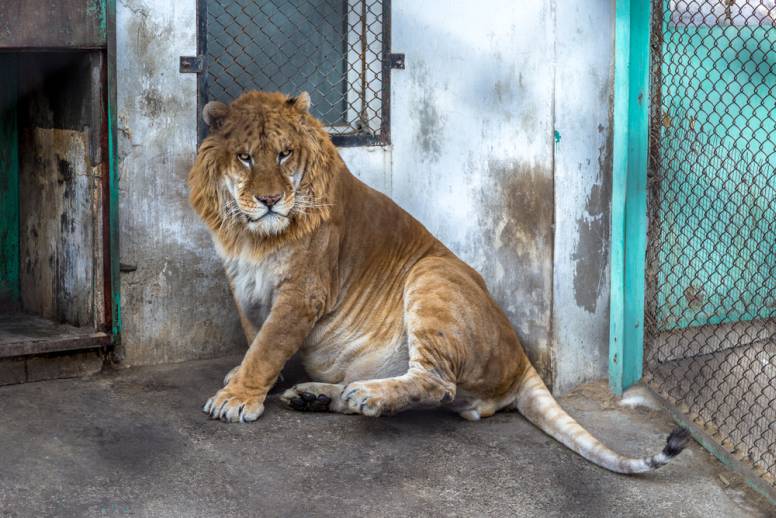
South Korea, Germany, Russia and South Africa each have a few Ligers in captivity.
3. Ligers often suffer from obesity because they don’t get enough exercise in their small habitats and cages.
This makes them even larger. A Liger named Nook living in the Valley of the Kings animal sanctuary in Wisconsin weighed over 1,200-pounds (before dying in 2007).4. Ligers can experience gigantism while dwarfism is known to occur in Tigons.
Animals species have a natural hormone that stops them from over growing in one of their parents. A slight mutation can stop them having it. But in the case of a liger, it’s the female lion which carries the hormone to stop growth. So a male lion genes combined with a female tiger results in a much larger cat in the form of a liger.5. The Liger is not alone as being a large cat hybrid.
There are other big cat hybrids that can measure up close to the size of the Liger. The Litigon, which happens to be a rare hybrid from a male Lion and female Tigon, can grow to just about the same size as the Liger. One such example was a male Litagon named Cubanacan who weighed a total of 800-pounds. He lived in the Alipore Zoo in India.6. Ligers appear to have a growth spurt early in the lives.
Hormonal issues probably contribute to this. The Liger grows fast when very young and then slows down as it approaches their adult size. By the time they reach six years of age, all the growing has taken place. The female Liger is also large in size growing up to 700-pounds and a length of 10-feet.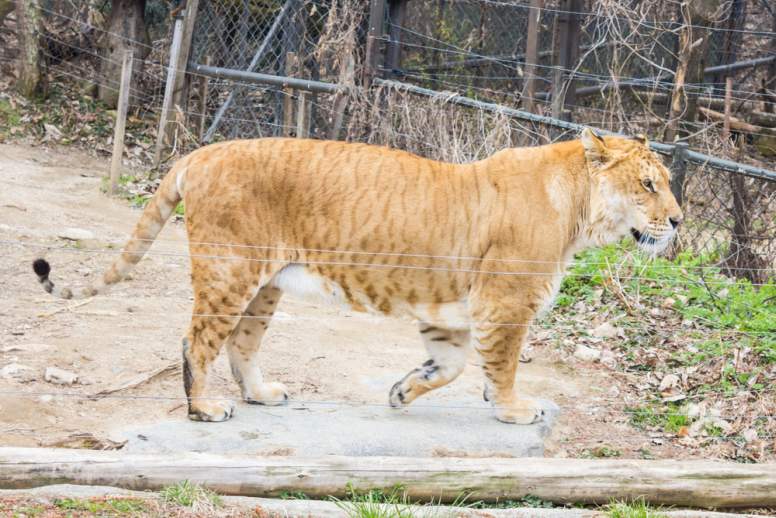
7. Ligers have relatively long lives.
A female Liger named Shasta born in 1948 at the Hogle Zoo in Salt Lake City, Utah lived to the age of 24. Hobbs, a male Liger lived to just about 15 years. He was in the Sierra Safari Zoo in Reno, Nevada and succumbed to liver failure.8. Hybrid big cats are known to be fertile.
There is a great deal of documentation on this subject. In fact, the fertility of big cat females includes many different hybrids. There is actually a rule that describes it: in hybrid animals, where their sex is determined by sex chromosomes, if one sex is absent, rare or happens to be sterile, the animal will be born heterogametric – the sex that had two different sex chromosomes. It is called Haldane’s Rule. There are other hybrids in the animal kingdom that are actually sterile.9. Ligers are fast. They have been clocked running up to 50mph.
The size of the liger does not inhibit their running speed, they are as fast as a Lion and generally considered by experts as faster. If you were being chased by one, the weight of the animal hitting you would knock the wind out of you, or render you unconscious.10. The Liger shares more traits with a lion, than a tiger.
As a Liger is the hybrid offspring of a Lion and a Tiger, it carries many different traits from both parents. However, the Liger has far more traits from the Lion parent than it does from the Tiger parent.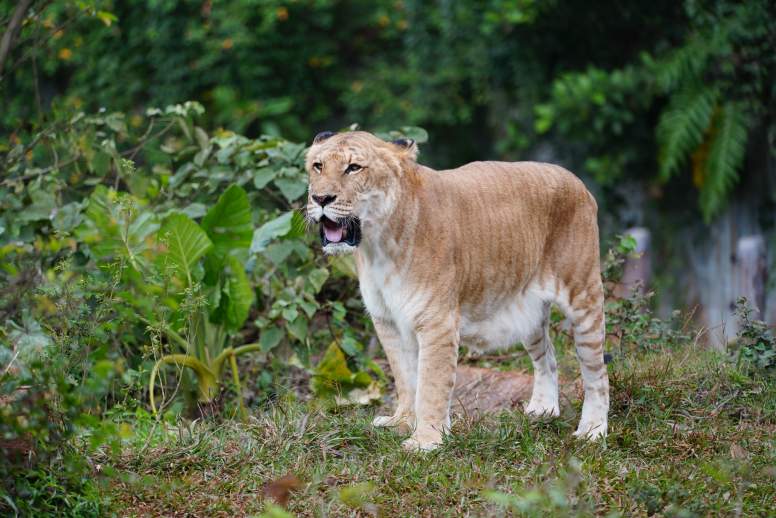
Or at least that is the findings of several researchers who have observed Ligers both in the wild and in captivity. Naturally, they live longer in captivity than in the wild.
11. A Ligers roar sounds like a lion.
As the Liger is essentially a cross between a Tiger and a Lion, the Liger roar sounds a lot like the roar of a Lion. However, there are circumstances when the Liger roar will sound more like the roar of a Tiger as well.12. The majority of Ligers born until recent decades, were actually the result of accidents.
That is to say, the breeding was not intentional. However, more recently they have been bred purposefully in captivity as a unique attraction.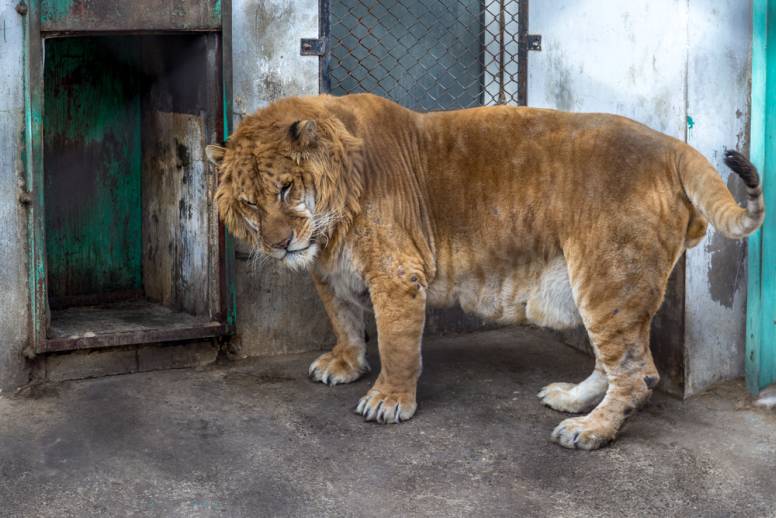
13. Lions and tigers don’t overlap in the wild today, except in one location – India’s Gir Forest.
Until now, no ligers have been found there. Typically they don’t cross the species line, and are not interested in each other. It’s been argued that crossbreeding will only occur in unique circumstances, such as when stuck in captivity and there are no other mates available of the same species.14. Ligers having poor immune systems is a myth.
While it’s often argued that one of the problems of being a hybrid is that the immunity system gets compromised, actually Ligers appear to have hybrid vigor. This means quite the opposite, they are often fit, healthy, bigger and stronger. However, while Ligers haven’t been studied at great length, there are arguments that they have a greater chance of genetic issues and other defects.15. The tiger mother requires help at birth.
As the Liger is considered one of the biggest cats on the planet, the Tiger mother usually requires a C-section in order to properly deliver the Liger cub as it will be larger than a normal Tiger cub.16. Ligers were popularised in the 2004 cult classic movie, Napoleon Dynamite.
The liger was ‘pretty much’ the favourite animal of the socially awkward Napoleon.<span style="display: inline-block; width: 0px; overflow: hidden; line-height: 0;" data-mce-type="bookmark" class="mce_SELRES_start"></span><span style="display: inline-block; width: 0px; overflow: hidden; line-height: 0;" data-mce-type="bookmark" class="mce_SELRES_start"></span><span style="display: inline-block; width: 0px; overflow: hidden; line-height: 0;" data-mce-type="bookmark" class="mce_SELRES_start"></span>
He’d spend time doodling them, and other fantasy creatures.
17. Crossbreeding of Ligers is often considered as unethical.
Conservation scientist Luke Dollar argues that any crossbreeding
between big cat species is unethical and is the result of greed or
irresponsible breeding.
Textual quote, web site: https://factanimal.com/ligers/
“I can think of no legit excuse for a liger or tigon to exist. If we want to recognize and honor big cats as they naturally occur in the wild, why would we possibly experiment in these completely unnatural and not biologically founded practices?”Accredited zoos frown on crossbreeding big cats and often Ligers can be found in private hands and outside main zoos.
18. The Association of Zoos and Aquariums (AZA), the accrediting body for zoos in North America, does not approve of Ligers.
Steve Feldman a spokesperson from the AZA says Zoos should instead focus on wildlife-conservation programs.Textual quote, web site: https://factanimal.com/ligers/
sábado, 20 de abril de 2019
Liger Population in USA
According to the official estimates, there are more than 50 ligers in USA only. These 50 ligers live at different zoos, animal sanctuaries, animal safari parks, animal reserves and animal rescue centers. The official count of such zoos and sanctuaries etc. with ligers is in between 24 to 28. Over the years; we have witnessed that more and more numbers of zoos and animal sanctuaries within United States are accumulating the ligers within their premises.
"The USA has at least 50 ligers at its different zoos and animal sanctuaries etc. and there might be more ligers in USA living in different private facilities across the country".
Some of them have a single liger while others might have as many as almost a dozen numbers of ligers. The chances are there might be more than 50 ligers in United States because a lot of private properties and private animal reserves have ligers and their official count is almost impossible to make. Therefore; let's stick with the official number of ligers as the 50 and explore further about liger counts from different perspectives in this write-up.
"The USA has at least 50 ligers at its different zoos and animal sanctuaries etc. and there might be more ligers in USA living in different private facilities across the country".
Some of them have a single liger while others might have as many as almost a dozen numbers of ligers. The chances are there might be more than 50 ligers in United States because a lot of private properties and private animal reserves have ligers and their official count is almost impossible to make. Therefore; let's stick with the official number of ligers as the 50 and explore further about liger counts from different perspectives in this write-up.
Population of Ligers in USA
50+ Ligers in USA Numbers of Total Zoos etc.
24 to 28 US Zoos with Ligers Numbers of Ligers in Each Zoo
As Low as 1, as high as 12 Ligers in Private Residences
Not-Countable Chances are
Numbers of Ligers will be higher than 50 Ligers
If we compare the US population of the ligers with the rest of the world, the US liger population is way high as compared to the population of the ligers in other countries. The other main countries with a significant numbers of liger population include the China, Russia and the Thailand. These countries only started breeding the ligers within the 21st Century and within a decade or so they have also become one of the main references of the liger population in the world.
"The United States is the top country to have maximum population number of ligers i.e., 50 ligers. China has 25, Russia has 15 while Thailand has 8 to 10 ligers".
China has in between 20 to 25 ligers, Russia has around 12 to 15 ligers and Thailand has about 8 to 10 ligers at their different zoos, animal sanctuaries and safari parks etc. Even if we combine the numbers of ligers from these countries altogether, their total number marginally reaches the 50 liger mark. Therefore; with 50 numbers of ligers, the USA also tops the list to have maximum numbers of ligers by any country in the world.
The most popular animal safari park to have ligers in USA is the Myrtle Beach Safari. They are also one of the pioneers to introduce the ligers on the mainstream media. Myrtle Beach Safari is located at the Myrtle Beach, South Carolina, USA. Ligers are part of this safari park for decades. Over the years, the Myrtle Beach Safari has introduced a lot of ligers at its premises. Currently; the world's biggest liger i.e., Hercules the liger is also part of the Myrtle Beach Safari. Furthermore; the world's rarest white ligers are also part of the Myrtle Beach Safari.
Apart from Myrtle Beach Safari, the Wynnewood Zoo in Oklahoma, USA has the maximum numbers of ligers in USA. This zoo has as many as 12 ligers and most probably it is the only zoo in the world to have this many ligers at its premises. In addition to the ligers, the Wynnewood Zoo even has Li-ligers, Ti-ligers, Li3-Ligers and Ti3-Ligers as well. Apart from Wynnewood Zoo, other liger zoos and animal sanctuaries which have ligers have them in numbers of 1 or 2 only.
Another important statistic about the liger population within the USA is about the Floridian state. The state of Florida has the honor to have maximum numbers of zoos, safari parks and even foundations with ligers. There is also a great possibility that the Floridian state of USA, has more numbers of ligers than any other state (Oklahoma marginally closer) of USA. The Jungle Island and the Zoological Wildlife Foundation are the popular destinations in Florida for many years with ligers.
Other zoos and animal sanctuaries with ligers include McCarthy's Wildlife Sanctuary, Endangered Animal Rescue Sanctuary, Big Cat Habitat and Octagon Wildlife sanctuary. The Zoological Wildlife Foundation and the Octagon Wildlife Sanctuary are one of the newest ones to have ligers. Apart from Florida, as many as 13 states within USA have ligers.
A decade ago from the early 2000s to the late 2000s, there were hardly 15 to 20 ligers within very few number of states of United States. In 1980s and 1990s; there seems to be less than 10 ligers within United States and during those days Samson and Sudan were very famous ligers from South Carolina, USA. At the same time, the state of Michigan used to have more numbers of ligers than any other state within United States. In Michigan, a man named as Patrick Hoctor used to own at least 7 ligers at its private reserve.
The first ever liger in United States was born in 1948. It was Shasta the liger and she lived for 24 years and died in 1972. When Shasta died, she was the only liger in the world at that time. Shasta also holds the record for the longest living (24 years) liger in the world. These statistics indicate that from 1950s to 1970s, the population of the ligers within United States was merely a single or two ligers. The trend changed in 1980s and 1990s, when the liger population increased to around 1 dozen ligers. During the 2000s, it increased to 15 to 20 ligers and in 2010s, it further increased to almost 3 times with more than 50 ligers within USA.
Lastly; it is expected that the population of the ligers will grow further not only within United States but also in many countries all around the world. Currently; there are more than 100 ligers in the world and United States has more than 50% of this population share. Ligers are considered as one of the true brand ambassadors for the big cats.
The ligers captivate people's attention because of their unique and astonishing characteristics which also prompts people to take a very keen interest within the conservation of the big cats. Therefore; the expected rise within the liger population in future may further boost the conservation efforts within the big cats too along the way.
textual quote from web page:
http://www.ligerworld.com/liger-population-usa.html?fbclid=IwAR3B8ICtTHRW9Uqw1ev6QmR1H0NUG69JpRcKMqK9wPPciVbcyUVBDVGKkQAA roaring success, the world's first white ligers: Four brothers are rarest big cats on the planet
These adorable cubs may look cute and unassuming but they are in fact the rarest of their species – and could grow to be the biggest cats in the world.
The four handsome male ‘liger’ cubs are the first ever to be born from a white male lion and white female tiger, making them the world’s most unique big cats.
There are only around 300 white lions and 1,200 white tigers left in the world, so the cubs’ father, Ivory and mother, Saraswati, are extremely rare in their own right.
But now, having been brought together at Myrtle Beach Safari in South Carolina, they have produced the first ever white lion-tiger hybrids - commonly known as ligers.
There are around 1,000 ligers in the world – most in captivity – but none of them are white.
Born only six weeks ago, the young animals already weigh 15lbs and gain on average a pound in weight every day.
And the boys, named Yeti, Odlin, Sampson and Apollo, already have their own personalities.
Apollo is the smallest, who his owners say behaves more like a house kitten, purring all the time and always demanding to be stroked.
Yeti is the biggest and most boisterous, pushing past his smaller brothers and always wanting to be the centre of attention.
The cubs’ uncle, Hercules, is officially the world’s largest cat at 922 lbs and 131 inches long and is featured in the Guinness Book of World Records.
Founder and director of the safari, Dr Bhagavan Antle, who bred the animals, says he is sure Yeti will reach this size – if not larger.
‘I am convinced Yeti will make the Guinness Book of Records. He’s so big already – he has such a big, fat head and paws.
‘All the cubs grow so quickly, but Yeti is already so much bigger.
‘I skip a day seeing them and it looks like they’ve doubled in size. It’s like someone’s blowing them up with a tyre pump.’
Dr Antle, who set up the safari 31 years ago and had his first litter of ligers in 1988, said:
‘People are getting on planes to fly in to see them.
‘We’ve had everyone from Congress to people of all walks of life come. They are honestly such an incredibly unique sight.
‘They have a beautiful creamy colour that I’ve never seen on a cat before.'
The cubs are expected to reach 10ft tall by two years old and weigh around 750lbs.
When they are four-years-old they could weight over 900lbs.
Their father, Ivory, is a white African lion and their mother, Saraswati, is a snow white Bengal tiger.
Ligers tend to enjoy swimming, which is a characteristic of tigers, and are sociable like lions.
textual quote from web page: https://www.dailymail.co.uk/news/article-2534297/A-roaring-success-worlds-white-ligers-Four-brothers-rarest-big-cats-planet.html?fbclid=IwAR2lycRQutdfI1T6sarQfeWHNzbZK7xfNxHyrQ2Idap4qTNDrjYIaIA-Ouc
Suscribirse a:
Comentarios (Atom)



